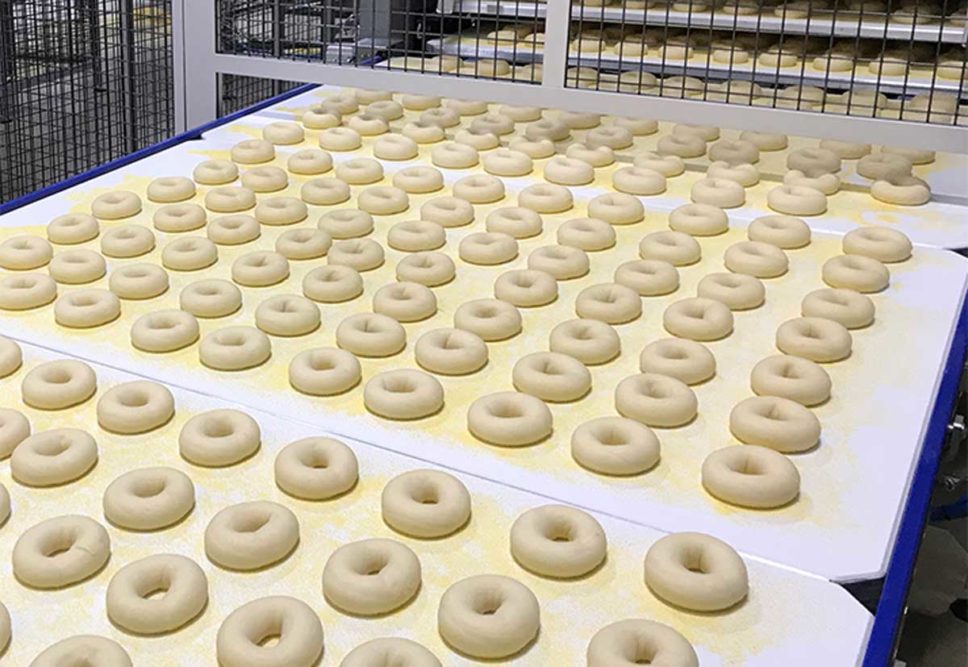The bagel’s characteristic shiny, chewy crust is developed through a combination of rest and boiling. After forming, bagels enter a two-step rest period: fermenting and retarding, which build flavor, volume and create a light skin that will develop into the crust in the boiler.
“These fermentation steps are particularly crucial in the bagel production process as they bring together a multitude of details essential to product quality and industrial performance,” said François Retailleau, product manager, Mecatherm.
To execute these steps well, operators must maintain tight control over the air flow and parameters in the proofer and retarder. During fermentation, bagels require high temperatures and high humidity with slow air speed, Mr. Retailleau said. Temperatures can reach up to 104°F. These conditions encourage bagels to reach their full volume. Lower humidity and temperatures — as low as 41° to 47°F — with faster air flow speeds helps set the volume and create a light skin on the product. This light skin provides protection to the smooth surface as the bagel moves into boiling.
“Boiling is an essential step that gives the bagel its shiny crust which is paradoxically both firm and supple,” said Alex Kuperman, chief executive officer, ABI Ltd. “The boiling step also impacts final product volume and crust thickness, so it is key to have good control of the boiling process.”
Technology has evolved to give bagel producers several methods to boil their bagels: steaming, waterfall boilers and submersion boiling. Each one delivers different crust characteristics.
“Waterfall boiling systems provide a thinner and crispier crust,” explained Ken Johnson, president, Gemini Bakery Equipment. “Using a submersible boiling system gives a thicker crust, which also benefits from a short amount of retarding to reduce belt impressions. Baking can include steaming in the oven, which creates a different crust and shine.”
The traditional method of boiling bagels is submersion. A top conveyor holds the bagels in place as they are submerged in the boiler. While this ensures proper registration, or positioning, throughout boiling, the top conveyor can leave marks on the bagels if they aren’t retarded properly. Optimized retarding to get that initial thin skin is so critical to product quality.
“The skin that is formed during the retarding process provides bagels with the required integrity to minimize top marking,” Mr. Kuperman said.
The other challenge that can crop up involves improper submerging during boiling. If bagels are not fully under water, the registration is lost and products can kiss or stick together during baking, another undesirable outcome.
It’s not just technique, however. The quality of the water in the boiler will also impact finished product quality.
[Related reading: Sticky bagels need special care at the oven]
“Many of the challenges in the boiling equipment stem from maintenance and maintainability of the unit,”
Said Jerry Barnes, vice president, Babbco. “Debris in the water stream must be filtered out to prevent caking on and failure of immersion heating elements, clogged nozzles and inconsistent product appearance.”
When debris hinders the boiler’s function, it adversely affects product quality. Water must be routinely cleaned.
“After so many hours of running, bakeries have to change the kettle water because it gets contaminated by starch,” explained John Borowski, master baker and bagel specialist, WP Bakery Group USA Winkler division. “Without cleaning properly and often enough, you get a cloudy film on the exterior bagel, which affects appearance and taste.”
Babbco uses a continuous filtration system and bottom rake to move sediment and debris toward the kettle’s drain. The company recently added a steam-heating process that makes cleaning the system easier.
“This new development improves ease of cleaning as it eliminates the need for heating pipes inside the tank and therefore improves the cleaning access,” Mr. Barnes explained.
Waterfall boiling is a way to get around the challenges of submersion altogether while still achieving the bagel’s characteristic skin. According to Mr. Kuperman, not only does it eliminate both marking and product registration issues, it also uses less water.
Babbco addresses those challenges of marking, registration and water quality with a spray system in a clam-shell frame. Dual path filtering and spray bars enable bakers to increase uptime. The system also gives bakers a great deal of control over the spray, providing consistent coverage of the product.
“This level of control is more important than before as many producers are opting out of the retarding step,” Mr. Barnes said.
This article is an excerpt from the February 2021 issue of Baking & Snack. To read the entire feature on bagel processing, click here.





